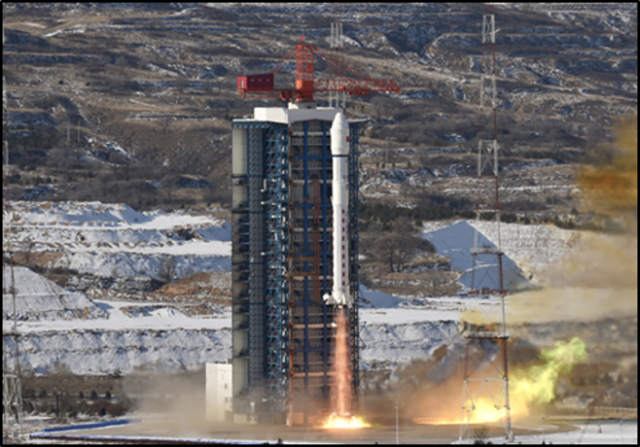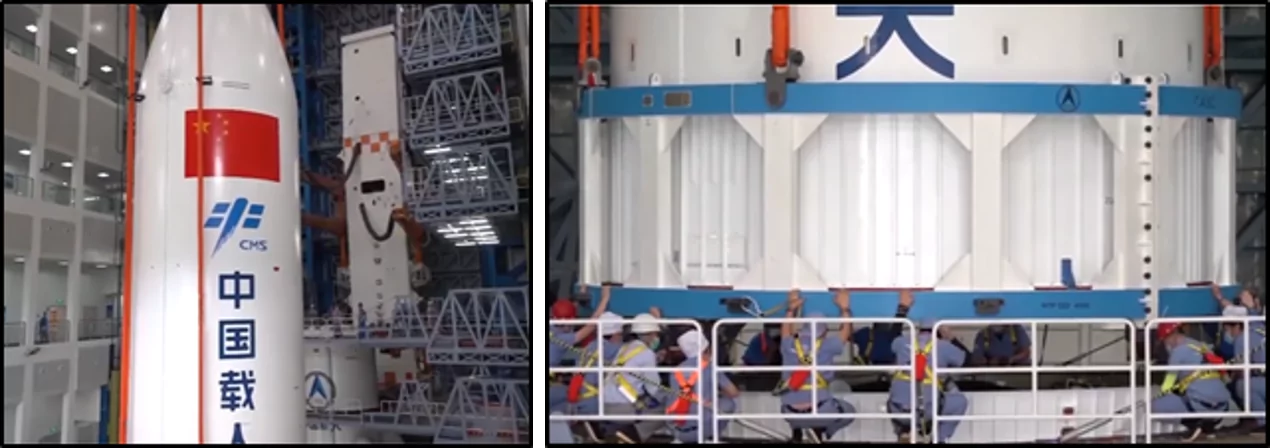
China’s Long March Rocket Program Sees Both Dramatic Successes and Failures in Spring 2020
Publication: China Brief Volume: 20 Issue: 9
By:

Introduction
The early months of 2020 have seen a number of significant launches for the People’s Republic of China (PRC)’s Long March series of rockets (长征系列运载火箭, Chang Zheng xilie yunzai huojian). The venerable—but steadily evolving—Long March series dates its active history back to China’s first satellite launch in 1970, and has long been the primary workhorse for launches associated with the PRC’s satellite and space exploration programs. These programs are increasingly ambitious in scope, and launch activities in 2020 may exceed those of last year: PRC state media indicated early this year that at least 40 Long March launch missions “to serve national space programs” were planned for 2020, with intent to surpass the 34 launches made in 2019 (Zhongguo Qingnian Bao, January 20; China Daily, February 20).
The early months of 2020 have seen continued successes for the PRC’s launch programs—to include the delivery into orbit of new satellites, and the successful maiden launch of a Long March 5B and associated payloads intended to play a future role in the PRC’s manned space program. However, there have also been major setbacks, as seen in the critical failures of two launch missions in mid-March and early April. It remains to be seen to what extent these two failed missions will impact the PRC’s ambitious launch schedule projected at the outset of the year.
Successful Satellite Launches in Early 2020
Much of the work for the Long March program is performed by subordinate institutions of the China Aerospace Science and Technology Corporation (中国航天科技集团有限公司, Zhongguo Hangtian Keji Jituan Youxian Gongsi], or CAST, one of the PRC’s two largest aerospace conglomerates. In particular, the CAST-subordinate China Great Wall Industry Corporation (中国长城工业集团有限公司, Zhongguo Changcheng Gongye Jituan Youxian Gongsi] is the lead institution for managing Long March launch services, operating out of three primary facilities: the Taiyuan (太原) Launch Center in northwest Shanxi Province; the Xichang (西昌) Launch Center in southern Sichuan Province; and the Wenchang (文昌) Launch Center on Hainan Island (Great Wall Industry Corporation, undated).
The PRC’s 2020 cycle of Long March missions commenced on January 7, with a Long March 3B launch that delivered into geostationary orbit a Tongxin Jishu Shiyan 5 (通信技术试验卫星五号) satellite, designed by the CAST-subordinate Shanghai Aerospace Technology Research Institute (上海航天技术研究院, Shanghai Hangtian Jishu Yanjiuyuan). PRC state press trumpeted the success of this launch, declaring that “This indicates that [CAST]’s first launch of 2020 has achieved a great start!” (Xinhua, January 8).
This was followed by three more successful satellite launch missions in the following weeks: a January 15 Long March 2D launch from the Taiyuan facility that carried into orbit two Chinese satellites, and two imaging satellites made by Satellogic, an Argentina-based company (Great Wall Industry Corporation, January 15); and a February 20 Long March-2D launch from the Xichang facility that orbited four satellites “tasked with demonstrating and verifying new technologies for intersatellite links as well as Earth observations” (China Daily, February 20). Also noteworthy was a Long March 3B launch on March 7 that placed into orbit another satellite of the Beidou (北斗) constellation of global positioning satellites, thereby reportedly placing the PRC “only one step away from completing the whole global system” (CAST, March 11).
| Long March Rocket Launches in 2020 | ||||
| Date | Location | Rocket | Mission / Reported Payload | Source(s) |
| Jan. 7 | Xichang Launch Center (Sichuan) | Long March 3B | Tongxin Jishu Shiyan 5 (通信技术试验卫星五号) satellite for delivery to geostationary orbit | (Xinhua, Jan. 8; Space Flight Now, Jan. 7; NASA Space Flight, Jan. 7) |
| Jan. 15 | Taiyuan Launch Center (Shanxi) | Long March 2D | Jilin 1 (吉林一号), Tianqi 5 (天启星座05星), Argentinian NewSat-7 and NewSat-8 satellites | (Shang Guan News, Jan. 15; China Great Wall Industry Corp., Jan. 15) |
| Feb. 20 | Xichang Launch Center (Sichuan) | Long March 2D | Four unidentified satellites for testing “intersatellite links” | (China Daily, Feb. 20) |
| Mar. 7 | Xichang Launch Center (Sichuan) | Long March 3B | The 54th satellite of the Beidou constellation of global positioning satellites | (CAST, March 11) |
| Mar. 16 | Wenchang Launch Center (Hainan) | Long March 7A | Maiden test flight of the Long March 7A; rocket suffered critical failure | (Xinhua, Mar. 16; (SCMP, Mar. 18) |
| Mar. 24 | Xichang Launch Center (Sichuan) | Long March 2C | Unidentified number of remote sensing satellites from the Yaogan-30 (遥感30号) series | (Xinhua, Mar. 24)
|
| Apr. 9 | Xichang Launch Center (Sichuan) | Long March 3B | Indonesian communication satellite Palapa-N1 for delivery into orbit; rocket suffered critical failure | (Xinhua, Apr. 9)
|
| May 5 | Wenchang Launch Center (Hainan) | Long March 5B | Maiden test flight of the Long March 5B; carried aloft a “next-generation manned spacecraft” for orbital testing | (China Daily, May 5; China Daily, May 6) |
Two Significant Launch Failures in March and April
Despite this successful record of satellite launches in the first several weeks of the month, a shadow was cast over the PRC’s rocketry program by major launch failures in mid-March and early April. On March 16, a Long March-7A carrier rocket was launched on a maiden flight from the Wenchang Space Launch Center in Hainan Province, reportedly on a mission to place an unidentified satellite into geosynchronous orbit (Space News, March 16). Later that day, state media carried a terse announcement that the rocket had “experienced an abnormality” (出现异常, chuxian yichang), and that the launch mission failed as a result, with an investigation to be conducted into the cause (Xinhua, March 16).
The Long March-7A has been identified as a payload rocket to deliver equipment and supplies for China’s future manned space station, thereby making the launch failure a setback for that program. Unverified amateur video posted online appeared to show an explosion approximately three minutes into the flight, leading to media speculation that the rocket experienced a critical failure in second-stage separation (SCMP, March 18). However, no official cause has been made public.
A second significant failure occurred on April 9, when a Long March 3B launched from the Xichang Launch Center (Sichuan Province) was also destroyed in flight. A statement from Xinhua about this incident was more forthcoming, stating that “The rocket worked in normal conditions in the first-stage and second-stage [but] abnormal conditions happened in the third-stage…Debris of the third-stage rocket and satellite had fallen, and the launch mission suffered a failure.” The rocket carried an Indonesian Palapa-N1 communication satellite for delivery into orbit, which was presumably also destroyed (Xinhua, April 9).


The Long March 5B and the Test Orbiting of Its Manned Spaceflight Capsule
The sting of these two failures was alleviated somewhat by the successful May 5 maiden launch of a Long March 5B from the Wenchang Launch Center on Hainan Island. The Long March 5B is a new variant that is reportedly the largest of the PRC’s space-going rockets, and “central to the space station program [as] the only Chinese launch vehicle capable of carrying large space station parts into orbit.” Per a spokesman for the China Manned Space Agency, three future Long March 5B flights are planned to put major components of China’s manned space station aloft for assembly in orbit; and “four Long March 2F and four Long March 7 missions will be made by the end of 2022 to ferry astronauts and cargo ships to build the station” (China Daily, May 5; China Daily, May 6).
Per state media, the rocket “placed prototypes of China’s next-generation manned spacecraft and an experimental cargo retrieval craft as well as more than 10 experimental payloads in low-Earth orbit” (China Daily, May 6). Successful testing of this “new-generation manned spaceship” (albeit unmanned for this flight), which is intended to support future manned lunar missions (People’s Daily Online, May 8), was particularly promoted as a dramatic success story. Xinhua reported that “the experimental spaceship flew in orbit for two days and 19 hours, during which it carried out a series of space science and technology experiments” before returning to Earth’s atmosphere and conducting a successful landing via parachutes at the Dongfeng (东风) landing site in Inner Mongolia (Xinhua, May 8). State media also issued a brief statement that the “flexible and inflatable cargo return capsule that China sent into space for test for the first time operated abnormally during its return to the ground” (Xinhua, May 10), but this sour note was obscured amidst the larger good news story about the successes of the Long March 5B and the manned spaceflight capsule.
Conclusion
This string of combined successes and failures for Long March rockets in early 2020 is likely to impact the PRC’s launches through the remainder of the year. At least one more major challenge lies ahead this year for China’s space program: in March, PRC officials announced successful testing that would open the way for a Tianwen-1 (天问一号) Mars probe launch to take place in July on a Long March-5 carrier rocket, with plans for the probe to “orbit and land and deploy a rover on the planet” (Xinhua, January 23; Xinhua, March 10; Xinhua, April 24). It remains to be seen whether or not the failed launches of March 16 and April 9 will delay this high-profile event, or whether they will cut into the forty Long March launches for 2020 predicted at the beginning of the year. Whichever the case, continued rapid advancements in China’s space program are almost certain to continue.
John Dotson is the editor of China Brief. For any comments, queries, or submissions, feel free to reach out to him at: cbeditor@jamestown.org.




